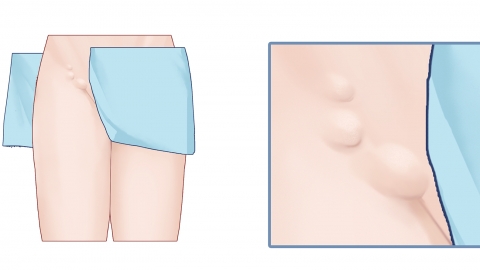What could be the reason for feeling a lump inside the groin area of the thigh?
Generally, a lump felt in the groin area of the thigh may be caused by muscle spasms after exercise, localized fat accumulation, lymphadenitis, sebaceous cysts, or inguinal hernia. Depending on the specific situation, patients can choose appropriate treatments such as conservative management, medication, or surgery. Detailed analysis is as follows:

1. Muscle Spasm After Exercise
After intense physical activity, muscles in the groin area may become tense and spasm, forming a hard, knot-like lump accompanied by mild soreness. Immediately stop exercising and rest in a seated or lying position. Gently massage the lump to relieve muscle tension, or apply heat to improve local blood circulation. Always perform proper warm-up exercises before future workouts to avoid sudden strenuous activity.
2. Localized Fat Accumulation
Prolonged sitting or a high-fat diet can lead to fat buildup in the groin, forming a soft, painless lump. Adjust your diet by reducing intake of fried and high-sugar foods, and increase consumption of vegetables and whole grains. Engage in daily physical activities such as walking or jogging to promote fat metabolism, and avoid prolonged sitting by standing up and moving regularly.
3. Lymphadenitis
Infections from the lower limbs or perineal region may spread to the inguinal lymph nodes, causing inflammation and resulting in swollen, painful lumps. Under medical guidance, antibiotics such as cefradine capsules, amoxicillin capsules, or levofloxacin hydrochloride capsules may be prescribed. Keep the area clean during treatment, avoid squeezing the lump, and actively treat the primary infection source.
4. Sebaceous Cyst
When sebaceous gland ducts in the groin become blocked, sebum accumulates and forms a cyst, appearing as a round lump that may become secondarily infected. If there is no infection, observation may suffice. If redness, swelling, and pain occur, topical medications such as mupirocin ointment, fusidic acid cream, or compound polymyxin B ointment may be used under medical supervision. After inflammation resolves, surgical excision of the cyst may be performed.
5. Inguinal Hernia
When the abdominal wall is weak or intra-abdominal pressure increases, abdominal contents may protrude into the groin, forming a noticeable lump that becomes more prominent when standing or straining. Avoid behaviors that increase abdominal pressure, such as severe coughing or constipation. Seek timely medical care for inguinal hernia repair surgery. After surgery, avoid heavy physical labor, keep the wound clean, and prevent infection.
Daily care includes maintaining cleanliness and dryness of the groin skin, avoiding friction and irritation; engaging in regular exercise to strengthen abdominal muscles; eating a balanced diet to prevent constipation; refraining from squeezing any lumps and seeking prompt medical evaluation to determine their nature; following postoperative instructions carefully and attending regular follow-ups to reduce the risk of recurrence.




